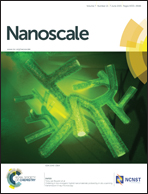Investigation of molecular mechanisms and regulatory pathways of pro-angiogenic nanorods†
Abstract
Angiogenesis, a process involving the growth of new blood vessels from the pre-existing vasculature, plays a crucial role in various pathophysiological conditions. We have previously demonstrated that europium hydroxide [EuIII(OH)3] nanorods (EHNs) exhibit pro-angiogenic properties through the generation of reactive oxygen species (ROS) and mitogen activated protein kinase (MAPK) activation. Considering the enormous implication of angiogenesis in cardiovascular diseases (CVDs) and cancer, it is essential to understand in-depth molecular mechanisms and signaling pathways in order to develop the most efficient and effective alternative treatment strategy for CVDs. However, the exact underlying mechanism and cascade signaling pathways behind the pro-angiogenic properties exhibited by EHNs still remain unclear. Herein, we report for the first time that the hydrogen peroxide (H2O2), a redox signaling molecule, generated by these EHNs activates the endothelial nitric oxide synthase (eNOS) that promotes the nitric oxide (NO) production in a PI3K (phosphoinositide 3-kinase)/Akt dependent manner, eventually triggering angiogenesis. We intensely believe that the investigation and understanding of the in-depth molecular mechanism and signaling pathways of EHNs induced angiogenesis will help us in developing an effective alternative treatment strategy for cardiovascular related and ischemic diseases where angiogenesis plays an important role.


 Please wait while we load your content...
Please wait while we load your content...